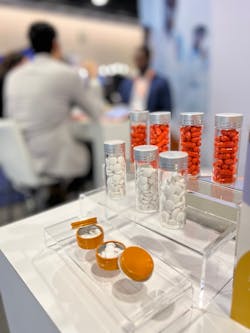Expediting drug development with innovative ingredients
The U.S. population is currently undergoing unprecedented change. For the first time in history, adults aged 60 years and older will outnumber children by 2034 and the number of adults over 80 years of age is expected to triple by 2050.
As the country’s demographic heads rapidly toward an aging population, a variety of societal issues will come to light, including labor and supply shortages with a dwindling qualified workforce and increased expenses for long-term care. In tandem with this, there is a rising need for more specialized, custom medications and generic, cost-sensitive drugs on the market.
In order to meet these consumer and societal demands, the U.S. pharma industry must place an increased emphasis on implementing a more robust drug development cycle. Currently there are several bottlenecks in the product development cycle, including phases of research and development, supply chain, manufacturing and commercialization.
Although many potential solutions exist, the current rise in innovative ingredient solutions and ingredient technology pose as a strong contender, deserving of in-depth exploration.
Sourcing the right ingredients
Throughout the product development cycle, formulation scientists encounter common issues related to sourcing the right ingredients, cost savings and scaling up for commercialization.
Sourcing the right quality ingredients and utilizing them in the proper amounts in drug formulations plays a crucial part in the development and scale-up phases. A small variation in ingredient quantity within any drug formulation may vastly affect many aspects of the final product ranging from attributes such as texture, viscosity and hardness to delivery effectiveness for patients. For instance, for oral solid dosage forms, tablets may experience physical defects such as capping or lamination or simply may not be producible.
The same applies even if the ingredient chosen exhibits the same chemistry but does not adhere to the same quality standards. In these instances, the efficacy and potency of the active pharmaceutical ingredient (API) formulated within the tablet may not pass quality control tests such as dissolution or disintegration, which can ultimately cause failure to meet label claims. Adjustments as simple as the quantity, quality or type of ingredient can have significant downstream ramifications.
One solution to these challenges comes in the form of co-processed excipients (CPEs). In recent years, these excipients have risen to the forefront as a valuable solution in troubleshooting common product development issues, specifically in the oral solid dosage space.
The blended benefits of CPEs
What defines a co-processed excipient? The development consists of selecting several commonly used and established excipients that are then combined into a singular blend, which exhibits more uniformity than traditional excipients. Each excipient within these blends is chosen for its individual ingredient characteristics and functions within a tablet formulation. Ingredient characteristics most typically desired during the preparation of CPEs exhibit properties and functions such as lubricants, flow aids, binders and diluents.
When co-processed together, individual excipient attributes can be enhanced and, at optimized ratios, allow for a more homogenous mixture in one single blend. Co-processing can be accomplished through a variety of methods such as spray drying, dehydration or granulation, and final blends have continuously proven better performance when compared to individual ingredients processed under standard manufacturing processes. Some of the many advantages that co-processed excipients bring to a formulation include improved powder flow, lubrication and uniformity of particle sizes — all of which contribute to powder and tablet compressibility benefits.
Additionally, co-processed excipients bring significant benefits to the product development cycle. Incorporating CPEs into drug formulations relieves pressures on ingredient sourcing, can lead to cost-savings and can ease challenges associated with scaling up from clinical trial phases into mass commercialization. No matter where drugmakers are in the manufacturing process, these benefits can be realized without compromising product quality or efficacy.
Cost savings today
During the ingredient sourcing stage, co-processed excipients also help reduce the number of ingredients required for sourcing and validation.
For example, in a single drug formulation, one co-processed excipient may accomplish the same, or better, functions of three or four ingredients. This leads to less time R&D specialists must contribute to sampling and validation processes and can often expedite the formulation development stage.
Applying this to the overall drug development cycle, a shortened development stage results in less time weighing and manufacturing ingredients and less waste produced. Additionally, with less powder needed in the formulation, sustainability benefits arise with the realization of reduced cleaning solvents and operator time necessary in manufacturing.
When scaling up from benchtop to pilot and ultimately to commercialization, these benefits become even more noticeable and can make a real difference for pharma manufacturers and the industry as a whole. When specifically examining the advantages of CPEs in the benchtop testing phase, fewer ingredient quantities are used, further reducing time, waste, physical warehouse space for storage, and cleanup time needed to produce small batch quantities.
From a patient and packaging standpoint, drug formulations utilizing co-processed excipients may result in physically smaller tablets due to less powder being weighed and compressed — thus optimizing and decreasing the thickness and diameter of the final dosage form. As the world realizes an increased aging population combined with common challenges of patient pill fatigue, smaller tablet sizes present tremendous long-term benefits. This translates to smaller blister packaging and bottles required to store and transport tablets, saving costs with packaging materials and shipping while contributing to sustainability goals.
These ambitious standards allow pharma and health care industries to better serve customers, employees and partners so that together, they can shape a better tomorrow.Microencapsulation technology
Another innovative ingredient solution making its mark on the pharma industry is the process and technology behind microencapsulation. While this technology has been widely used in industries such as personal care, food and textiles for many years, more recently it has progressively advanced in pharma applications. One such instance involves sensitive APIs which may be easily susceptible to degradation when exposed to environmental factors such as heat, humidity, oxygen or light.
Through the microencapsulation process, the API is coated with a protective outer layer designed to help prevent degradation or improve stability. Recent advancements have taken applied microencapsulation even further to include a wide range of ingredients, ranging from vitamins and proteins to mammalian and stem cells. These newly coated substances are continuously demonstrating increased stability and easier formulation capabilities and functions during the product development stages.
To illustrate the impact of microencapsulation, we can explore the common issue revolving around APIs that exhibit hygroscopic properties. When these APIs lack protective coating, the active ingredient is compromised the minute the original container packaging is opened and air or moisture is introduced. Furthermore, depending on the manufacturing process, that active ingredient may be exposed to the elements for prolonged periods of time, drawing in excess moisture from the air, and consequently changing the physical characteristics of the ingredient. In some cases, the powder may change from a free-flowing powder into a more crystalline structure leading to more time and complexity in the manufacturing process, contributing to increased ingredient waste, and the inability to guarantee quality and efficacy of the final drug product.
With a coated active ingredient, the hygroscopic characteristics are potentially negated, leading to improved ingredient and final product effectiveness and stability. Additionally, commonly used excipients that function as moisture protectants or antioxidants may no longer be required in the formulation, circling back to the same key benefits discussed earlier such as time savings in the development cycle and sustainability wins.
Beyond this, additional applications for microencapsulation include improved taste masking for bitter APIs, controlled release for drug delivery, active ingredient protection from the upper gastrointestinal tract and more targeted mechanisms of action. All these benefits help lead to an improvement in the bioavailability and therapeutic effects of the drug providing significant competitive advantages in the market and among the patient population.
Key considerations
While there are clearly many benefits of co-processed excipients and microencapsulation in the pharmaceutical space, we must acknowledge that no solution is perfect and there are some limitations to consider.
For example, with co-processed excipients, the ratio and type of excipient becomes fixed during co-processing stages. When formulating with unstable APIs, this means there may be cases where extra excipients are needed in the drug formulation as the existing ratio in the CPE may not be enough to provide stability — albeit the quantity of added excipients needed tend to be less than what would regularly be required without the use of co-processed excipients. Additionally, although the individual excipients used during the co-processing steps are monographed, the CPE blend itself may not yet be published in official monographs.
For microencapsulated ingredients, one potentially limiting and undeniable factor is the cost associated with the process. Outside of sourcing the proper active ingredient, there is an extra step in identifying the proper microencapsulation process to best suit the specific drug product qualities. Careful consideration is needed to evaluate the proper use in a formulation and optimization of the manufacturing cycle would be ideal in an effort to offset the upfront costs.
For both co-processed excipients and microencapsulated ingredients, any changes to the formulation will require reformulation and revalidation of the entire product development cycle. This proves particularly challenging and time-consuming when the drug product has already been commercialized. As a result, it is prudent to be aware of all the innovative solutions available during the initial drug development cycles so that the final drug product released onto the market can leverage competitive advantages.
Pharma innovation is here
As the world patient population and demographic continues to shift and grow, consumer factors such as ease of patient access, more palatable drugs, and pill fatigue play more important roles than ever in drug selection and administration. Fortunately, the rise in innovative ingredients and technologies brings with it a new wave of development for unique and desirable dosage forms. This is reflected in innovative dosage therapies such as mini tablets, bi-layer tablets, capsules in capsules, and more targeted cell and gene therapy applications. Previously unstable, poorly soluble or low bioavailability active ingredients may now be safely administered with less cost to the patient.
Ultimately, these innovative ingredients and technologies improve upon bottlenecks throughout the product development cycle such as research and development, supply chain, manufacturing and commercialization with the added benefit of improving the overall patient experience. The end-to-end drug development cycle is expedited and optimized, leading to the introduction of a more competitive and advantageous product to the market.
By optimizing and shortening the product development cycle through innovative solutions and technologies, manufacturers can realize positive benefits in the form of efficacy, quality and cost while developing and delivering more sustainable dosage forms that are better suited for the patient.
About the Author
Jessica Zhang
Technical Services Manager, Pharmaceutical Ingredients, Univar Solutions
Jessica Zhang is the Technical Services Manager - Pharmaceutical Ingredients for Univar Solutions. She holds a Bachelor of Science degree in biotechnology from the University of Houston. At Univar Solutions, Jessica leads the company’s pharmaceutical ingredients lab in its Houston Solution Center, which offers the latest equipment and capabilities to help drive innovative pharmaceutical ingredient solutions. Jessica oversees product development using various excipients and APIs and provides analytical and technical service support to the company’s customers and suppliers in North America. Prior to joining Univar Solutions, Jessica worked in the compounding industry where she manufactured non-sterile and sterile dosage forms, spent time in Quality Assurance/Quality Control (QA/QC), headed up the research and development (R&D) program and handled product development for various NS and sterile dosage forms.

